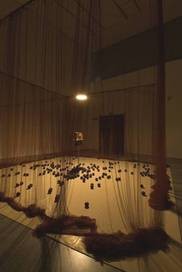Cildo Meireles
14 Oct 2008 - 11 Jan 2009
‘My work aspires to a condition of density, great simplicity, directness, openness of language and interaction.’
Cildo Meireles
A key instigator of Conceptual Art, Brazilian artist Cildo Meireles has made some of the most politically telling, aesthetically seductive and philosophically intriguing works of the last four decades. With a characteristic economy of means, he distils complex ideas into single objects or environments.
Meireles was born in 1948 in Rio de Janeiro, where he still lives and works. His father worked for the Indian Protection Service and, as a boy, the artist accompanied his family on their constant moves throughout the vast Brazilian territory. We often catch glimpses of these childhood experiences through his art.
His work inherited the legacy of Neo-concretism, a Brazilian movement of the late 1950s that rejected the extreme rationalism of geometric abstraction in favour of more sensorial, participatory works, which engage the body as well as the mind. The utopian optimism of the Neo-concrete artists foundered after the coup of 1964, which ushered in an oppressive military regime.
Meireles’s generation, emerging in the late 1960s and 1970s, were known for more politically engaged works, the extremity of their actions mirroring the extreme political situation. Meireles himself, however, links these two strands of Brazilian art.
‘In some way you become political when you don’t have a chance to be poetic. I think human beings would much prefer to be poetic’, he explains.
As Guy Brett, co-curator of this exhibition, has said, ‘A work by Meireles often starts in a commonplace, usually domestic object, or a childhood memory, which becomes transmuted into a perceptual, philosophical, even a cosmological speculation, without, however, losing its grit, its roots in social reality – a reality often harsh but marked by human resilience and inventiveness.’
Cildo Meireles
A key instigator of Conceptual Art, Brazilian artist Cildo Meireles has made some of the most politically telling, aesthetically seductive and philosophically intriguing works of the last four decades. With a characteristic economy of means, he distils complex ideas into single objects or environments.
Meireles was born in 1948 in Rio de Janeiro, where he still lives and works. His father worked for the Indian Protection Service and, as a boy, the artist accompanied his family on their constant moves throughout the vast Brazilian territory. We often catch glimpses of these childhood experiences through his art.
His work inherited the legacy of Neo-concretism, a Brazilian movement of the late 1950s that rejected the extreme rationalism of geometric abstraction in favour of more sensorial, participatory works, which engage the body as well as the mind. The utopian optimism of the Neo-concrete artists foundered after the coup of 1964, which ushered in an oppressive military regime.
Meireles’s generation, emerging in the late 1960s and 1970s, were known for more politically engaged works, the extremity of their actions mirroring the extreme political situation. Meireles himself, however, links these two strands of Brazilian art.
‘In some way you become political when you don’t have a chance to be poetic. I think human beings would much prefer to be poetic’, he explains.
As Guy Brett, co-curator of this exhibition, has said, ‘A work by Meireles often starts in a commonplace, usually domestic object, or a childhood memory, which becomes transmuted into a perceptual, philosophical, even a cosmological speculation, without, however, losing its grit, its roots in social reality – a reality often harsh but marked by human resilience and inventiveness.’

